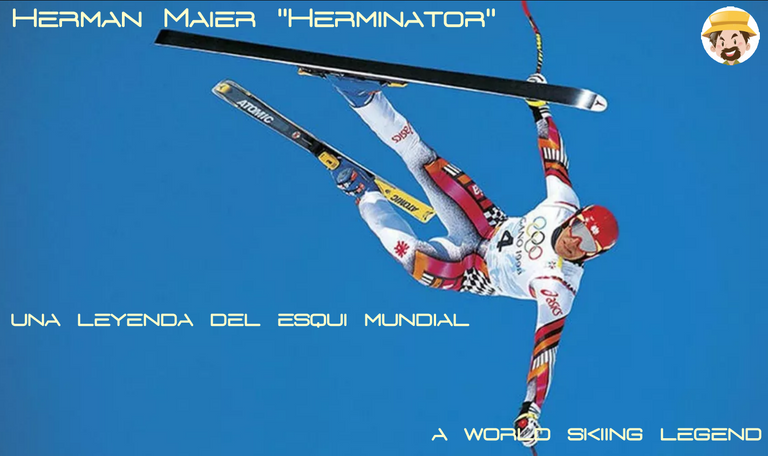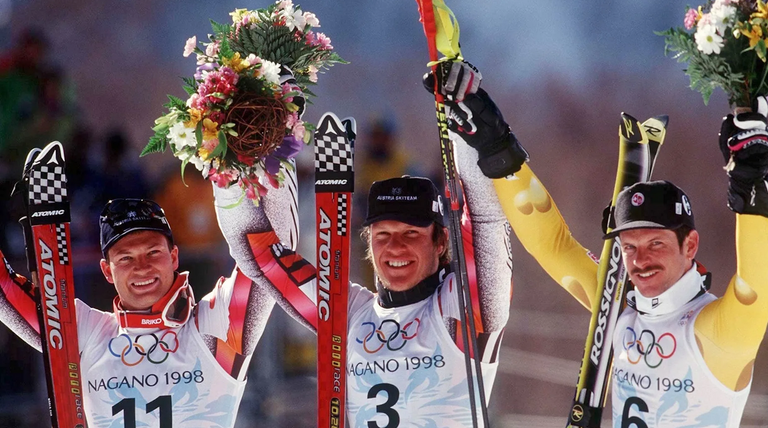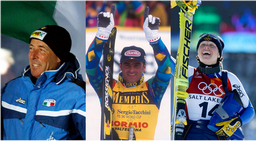
Para despuntar el vicio -como se decía años atrás aunque el concepto de aplicaba para fumar de vez en cuando y no para escribir artículos deportivos en la blockchain- sigo escribiendo hasta que llegue la Fórmula 1 compartiendo con todos los #hivers deportivos de esta espléndida comunidad, algunos aspectos curiosos, para algunos serán novedosos seguramente, de esta disciplina deportiva llamada esquí, muy poco practicada en Latinoamérica -a pesar de tener todos los ambientes naturales para hacerlo- y tan en auge en Europa, EE. UU. y algunos países asiáticos.
Me estoy refiriendo al esquí cuyo primer post introductorio en esta comunidad lo hice desde este enlace:
Hoy me voy a referir a uno de las leyendas vivientes de este deporte: el austríaco Herman Maier, apodado "Herminator" un acrónimo entre su nombre y el Terminator de Schwarzenegger propia por la característica pasión con la que enfrentaba cada competencia: ganar o ganar dejando muy poco espacio a la ilusión de sus rivales por la victoria.

In order to get the habit going - as they used to say years ago, although the concept applied to smoking from time to time and not to writing sports articles in the blockchain - I keep writing until Formula 1 arrives, sharing with all the #sportshivers of this splendid community, some curious aspects, which for some will surely be new, of this sport discipline called skiing, very little practiced in Latin America - despite having all the natural environments to do so - and so booming in Europe, USA and some Asian countries.
I am referring to skiing, whose first introductory post in this community I made from this link.
Today I am going to refer to one of the living legends of this sport: the Austrian Herman Maier, nicknamed "Herminator", an acronym between his name and Schwarzenegger's own Terminator because of the characteristic passion with which he faced each competition: win or win, leaving very little room for his rivals' illusion of victory.

Antes de entrar en el 2000 más precisamente durante las Olimpíadas Invernales celebradas en Nagano en 1998 una imagen espectacular circuló por todos los medios de difusión deportivos del planeta -Internet no tenía mínimamente la influencia ni el desarrollo tecnológico que tiene hoy-, tan espectacular como peligrosa: un esquiador que luego de resbalar sobre la nieve demasiado dura, en pleno descenso, volaba por el aire por casi cincuenta metros y aterrizaba algo descompuesto cayendo sobre la nieve y quedando eliminado de la prueba pero sin sufrir el mínimo daño corporal.
Parecía un stuntman de esos que reemplazan a los actores en las películas cuando se filman escenas de riesgo. Solo que en este caso todo era absolutamente real.
Recuerdo la imagen vívidamente porque hacía apenas cuatro años que vivía en Europa y seguía las competencias de esquí desde la TV todos los domingos antes del mediodía. No solo eran una novedad para mi sino que me gustaban mucho sobretodo por la precxisión milimétrica de los esquiadores alcanzando en algunos casos velocidad de un Fórmula 1 sólo sobre dos patines. Precisión en el eslalon al sortar todos los obstáculos en velocidad y en pocos metros. Velocidad pura en el descenso y en el llamado SuperG, una mezcla de ambos donde se suelen superar los 120 kms horarios sin ningún problema.. Era algo increíble.
Ironía del destino este extraordinario esquiador tuvo el accidente más grande de su vida y corrió el riesgo de perder una pierna no en una competencia sobre la nieve sino sobre su propia moto.
Su medallero personal es impresionante: 4 Copas del Mundo ganadas, otras 4 medallas en las Olimpíadas de Invierno de las cuáles dos de oro, 6 medallas en los Mundiales de Esquí, de las cuáles tres de oro y todo este palmares en medio de un accidente, dos años de estar parado a causa del mismo y el riesgo de verse amputada una pierna.
Herman Maier pertenecía a esa especie de dportistas para los cuáles el riesgo hace parte de su vida. Es el componente adicional para hacerles subir la adrenalina que hay en sus cuerpos y los transforma en los fenómenos deportivos que terminan siendo.
Herminator tenía la misma personalidad de un Valentino Rossi (hoy fuera de la carreras) en la MotoGP o de un Marc Márquez que este año reanuda la competencias luego de un grave accidente que lo tuvo parado más de un año.
O de Max Verstappen, Lewis Hamilton o tantos otros pilotos de la F1 que conviven con el peligro a diario. Es más, llevan el peligro a su valor extremo, sin importarle las consecuencias. Sin exagerar, podríamos decir que hacen del peligro la razón de su vida.
Cuando en el año 2009 Maier anuncia el fin de su carrera deportiva termina la carrera deportiva de uno de los más grandes campeones de todos los tiempos en la historia del esquí mundia, pero nace la leyenda, el mito, el afán de otros deportistas por superar sus récords.
Con 35 años (una edad evanzada para esquiar profesionalmente sobre todo por el tremendo desgaste que sufren m1sculos de las piernas y especialmente rodillas) y quince temporadas de competición el austríaco "Herminator" decía punto final a una carrera brillante y llena de éxitos. Para él competir no era suficiente, tenía que ganar, y al no poder hacerlo era mejor retirarse.
Perteneció a esa estirpe de verdaderos campeones que dejan todo en la pista. A veces hasta su propia integridad física.
El apodo de "Herminator" era debido a su físico macizo y a su agresividad en pista. Y a su extraordinaria fuerza de voluntad que le permitió recuperarse de un accidente gravísimo y volver a reconquistar después del 2001 los vértices del esquí alpino.

Before entering the year 2000, more precisely during the Winter Olympics held in Nagano in 1998, a spectacular image circulated all over the world's sports media - the Internet did not have the influence or the technological development it has today - as spectacular as it is dangerous: a skier who, after slipping on snow that was too hard, in the middle of a descent, flew through the air for almost fifty metres and landed somewhat discomposed, falling on the snow and being eliminated from the event but without suffering the slightest bodily harm.
He looked like one of those stuntmen who replace actors in the movies when filming stunts. Only in this case everything was absolutely real.
I remember the image vividly because it was only four years ago that I lived in Europe and followed the skiing competitions on TV every Sunday before noon. They were not only a novelty for me, but I liked them very much, especially because of the millimetric precision of the skiers, in some cases reaching Formula 1 speed on just two skates. Precision in the slalom by sorting all the obstacles at speed and in a few metres. Pure speed in the downhill and in the so-called SuperG, a mixture of both where they usually exceed 120 km per hour without any problem... It was unbelievable.
Ironically, this extraordinary skier had the biggest accident of his life and risked losing a leg not in a competition on snow but on his own motorbike.
His personal medal tally is impressive: 4 World Cup wins, 4 medals at the Winter Olympics, including two gold medals, 6 medals at the World Ski Championships, including three gold medals, and all this in the midst of an accident, two years of being paralysed because of it and the risk of having his leg amputated.
Herman Maier belonged to that kind of sportsmen for whom risk is part of their life. It is the additional component to get the adrenalin pumping in their bodies and transforms them into the sporting phenomena they end up being.
Herminator had the same personality of a Valentino Rossi (now out of racing) in MotoGP or of a Marc Marquez who this year resumes racing after a serious accident that kept him out of action for more than a year.
Or Max Verstappen, Lewis Hamilton or so many other F1 drivers who live with danger on a daily basis. What's more, they take danger to its extreme value, regardless of the consequences. Without exaggeration, we could say that they make danger the reason for their life.
When Maier announced the end of his sporting career in 2009, the sporting career of one of the greatest champions of all time in the history of world skiing came to an end, but the legend, the myth, the desire of other athletes to beat his records was born.
At the age of 35 (an advanced age for professional skiing, above all because of the tremendous wear and tear on the muscles of the legs and especially the knees) and fifteen seasons of competition, the Austrian "Herminator" put an end to a brilliant career full of successes. For him, competing was not enough, he had to win, and if he could not do so, it was better to retire.
He belonged to that lineage of true champions who leave everything on the track. Sometimes even his own physical integrity.
The nickname "Herminator" was due to his massive physique and his aggressiveness on the track. And to his extraordinary willpower that allowed him to recover from a very serious accident and to reconquer again after 2001 the summits of alpine skiing.
Traducción efectuada con DeepL Translator. / Translation made with DeepL Translator.

El banner titulado Reseñas Deportivas / Sports Reviews personalizado por el autor es propiedad de PNGWing.
The banner titled Reseñas Deportivas / Sports Reviews customized by the author is property of PNGWing.

La parte inferior del banner de la firma corresponde al badget elaborado por el equipo de @hivebuzz. Mi agradecimiento a ellos y en particular a @arcange
The lower part of the signature banner corresponds to the badget made by the @hivebuzz team. My thanks to them and in particular to @arcange

Congratulations on a job well done! We are thrilled to see the outstanding results you've achieved. Your dedication and hard work have truly paid off, and it's inspiring to witness the impact you've made. Keep up the fantastic work, and know that your contributions are valued and appreciated.